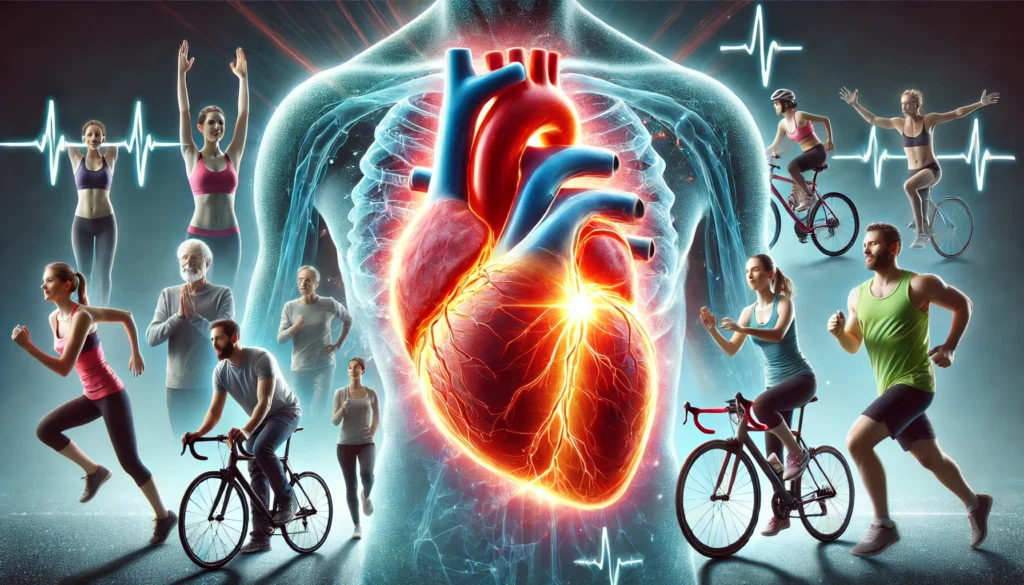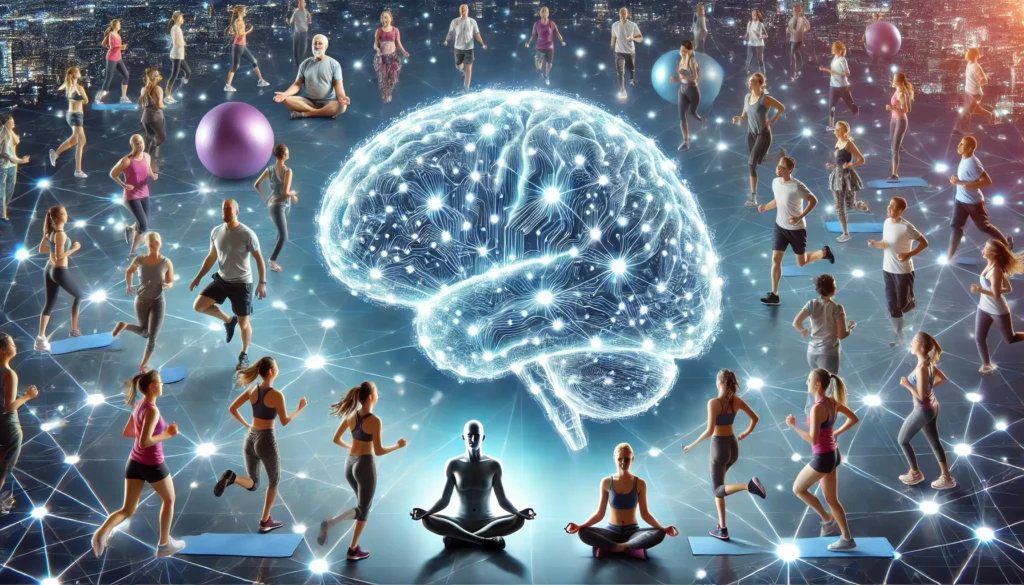Introduction
Physical activity is a fundamental pillar of health and well-being, playing a crucial role in preventing numerous chronic diseases. Modern scientific research consistently highlights the profound impact of regular physical movement on reducing the risk of illnesses across various bodily systems. From cardiovascular diseases to mental health disorders, engaging in consistent exercise has been shown to contribute significantly to longevity and quality of life.
You may also like: How Does Exercise Improve Mental Health? Science-Backed Benefits You Should Know
In a world increasingly dominated by sedentary lifestyles, it is vital to understand how movement functions as a preventive mechanism against illnesses. This article provides an in-depth exploration of the diseases that physical activity helps prevent, backed by scientific evidence, and explains the physiological and psychological mechanisms behind these protective effects. Readers will gain valuable insights into the specific ways in which physical activity safeguards health and how it can be integrated into daily routines for maximum benefit.
Cardiovascular Diseases: Protecting the Heart and Circulatory System
Cardiovascular diseases (CVDs) remain the leading cause of death worldwide, yet many of these conditions are largely preventable through lifestyle modifications, particularly regular physical movement. Exercise strengthens the heart muscle, improves circulation, and helps regulate blood pressure, reducing strain on the cardiovascular system.
One of the most significant benefits of physical activity is its role in maintaining optimal blood pressure levels. Hypertension, or high blood pressure, is a major risk factor for heart disease and stroke. Regular aerobic exercises such as walking, jogging, swimming, and cycling have been shown to lower systolic and diastolic blood pressure by enhancing the efficiency of the heart and promoting better vascular function. This effect is particularly beneficial for individuals at risk of developing hypertension or those already diagnosed with the condition.
Physical activity also helps regulate cholesterol levels. Engaging in consistent movement raises high-density lipoprotein (HDL), often referred to as “good” cholesterol, while simultaneously reducing low-density lipoprotein (LDL) or “bad” cholesterol. This balance is essential in preventing atherosclerosis, a condition characterized by plaque buildup in the arteries, which can lead to heart attacks and strokes.
Additionally, physical activity plays a role in reducing inflammation, which is a key contributor to the development of CVDs. Chronic inflammation can lead to endothelial dysfunction and arterial stiffness, both of which increase the likelihood of heart disease. Exercise helps to counteract these effects by promoting the release of anti-inflammatory molecules and improving endothelial function.
Type 2 Diabetes: Regulating Blood Sugar and Insulin Sensitivity
Type 2 diabetes is a metabolic disorder characterized by insulin resistance and elevated blood glucose levels. It is a growing health crisis worldwide, largely driven by sedentary lifestyles and poor dietary choices. Fortunately, regular physical activity serves as a powerful preventive measure against this condition.
Exercise improves insulin sensitivity, allowing cells to utilize glucose more efficiently and reducing the need for excessive insulin production. Both aerobic and resistance training exercises have been shown to enhance glucose uptake by muscles, thereby lowering blood sugar levels and decreasing the risk of developing type 2 diabetes.
Furthermore, physical movement aids in weight management, a crucial factor in diabetes prevention. Excess body weight, particularly visceral fat around the abdomen, is strongly associated with insulin resistance. By engaging in regular physical activity, individuals can reduce fat accumulation and maintain a healthy body composition, which significantly lowers diabetes risk.
Research also indicates that exercise promotes the function of pancreatic beta cells, which are responsible for insulin production. By preserving these cells’ health and function, regular movement helps maintain stable blood glucose levels and prevents the onset of type 2 diabetes.

Mental Health Disorders: Enhancing Cognitive and Emotional Well-Being
The benefits of physical activity extend beyond physical health; they also play a crucial role in mental and cognitive well-being. Mental health disorders such as depression and anxiety have become increasingly prevalent, often exacerbated by stress, social isolation, and sedentary behaviors. Fortunately, engaging in regular physical movement has been shown to have profound effects on mental health.
Exercise stimulates the release of endorphins, commonly known as “feel-good” hormones, which help alleviate stress and improve mood. This natural mood-boosting effect is particularly beneficial for individuals struggling with depression and anxiety disorders. Physical activity also increases levels of serotonin and dopamine, neurotransmitters associated with happiness and motivation, further contributing to mental well-being.
Moreover, regular movement enhances cognitive function and reduces the risk of neurodegenerative diseases such as Alzheimer’s and Parkinson’s. Physical activity promotes neuroplasticity, the brain’s ability to form new neural connections, and enhances blood flow to the brain, supplying it with essential nutrients and oxygen. These effects help protect against cognitive decline and improve memory, attention, and overall brain function.
Cancer Prevention: Reducing Risk Through Biological Mechanisms
Emerging research suggests that regular physical activity plays a role in reducing the risk of various types of cancer. Exercise helps regulate hormones such as insulin, estrogen, and growth factors, all of which influence cancer development. By maintaining hormonal balance, physical movement minimizes the likelihood of cancerous cell growth and proliferation.
Additionally, exercise enhances the immune system, enabling the body to detect and eliminate abnormal cells before they develop into malignancies. Physical activity also reduces chronic inflammation, a known contributor to cancer progression, and improves digestive health, lowering the risk of colorectal cancer.
Among the cancers most significantly impacted by physical activity are breast, colon, prostate, and lung cancer. Engaging in regular movement has been shown to reduce the risk of these cancers by up to 30%, highlighting the importance of an active lifestyle in cancer prevention.

Frequently Asked Questions (FAQ) on Physical Activity and Disease Prevention
1. How does physical activity specifically help prevent cardiovascular diseases?
Physical movement directly benefits the cardiovascular system by enhancing heart function, increasing oxygen flow, and reducing arterial stiffness. Engaging in regular aerobic activities such as swimming, running, or brisk walking strengthens the heart muscle, allowing it to pump blood more efficiently and reducing the risk of high blood pressure. Exercise also stimulates the production of nitric oxide, a molecule that helps relax blood vessels and improve circulation. This effect lowers the risk of plaque buildup, which is a leading cause of heart attacks and strokes. Furthermore, physical movement helps regulate lipid levels by increasing “good” HDL cholesterol while decreasing “bad” LDL cholesterol, which significantly reduces the likelihood of atherosclerosis.
2. What illness does physical activity help prevent in relation to metabolic health?
Physical activity plays a crucial role in preventing metabolic disorders such as type 2 diabetes and metabolic syndrome. Regular exercise improves insulin sensitivity, enabling the body to use glucose efficiently and maintain stable blood sugar levels. Resistance training, in particular, enhances muscle glucose uptake, reducing the risk of insulin resistance—a major factor in diabetes development. Additionally, movement helps combat visceral fat accumulation, which is strongly linked to metabolic dysfunction. By promoting efficient energy metabolism, exercise prevents disruptions in hormonal balance that could lead to weight gain and increased disease risk.
3. How does physical movement influence mental health and cognitive function?
Engaging in consistent physical movement has profound effects on mental well-being by reducing stress, anxiety, and depression. Exercise triggers the release of endorphins, neurotransmitters that create feelings of happiness and relaxation. It also enhances cognitive function by increasing blood flow to the brain, promoting neuroplasticity, and supporting the production of brain-derived neurotrophic factor (BDNF), which strengthens neural connections. Regular movement has been associated with a lower risk of cognitive decline and neurodegenerative diseases such as Alzheimer’s and Parkinson’s. Furthermore, the social aspect of many physical activities, such as team sports or group fitness classes, contributes to improved emotional well-being and a stronger support network.
4. Can physical activity help prevent certain cancers?
Yes, research indicates that physical movement reduces the risk of several types of cancer, including breast, colon, prostate, and lung cancer. One of the primary mechanisms is its ability to regulate hormone levels, such as estrogen and insulin, which influence cancer cell growth. Exercise also enhances immune function by improving the efficiency of natural killer cells, which help detect and destroy abnormal cells before they can develop into malignancies. Additionally, physical activity reduces chronic inflammation, a known contributor to cancer progression, by modulating inflammatory cytokines and oxidative stress. The improved digestive health associated with regular movement further reduces the risk of colorectal cancer by promoting efficient waste elimination and reducing exposure to carcinogens.
5. How does exercise prevent bone-related illnesses such as osteoporosis?
Weight-bearing and resistance exercises play a vital role in strengthening bones and preventing osteoporosis. Activities such as walking, running, and weightlifting stimulate bone remodeling by encouraging osteoblast activity, which enhances bone density. Physical movement also improves balance, coordination, and muscle strength, reducing the risk of falls and fractures. In addition, regular exercise helps maintain joint flexibility and cartilage health, decreasing the likelihood of developing osteoarthritis. The impact of movement on bone health is particularly significant in older adults, as it helps slow down the natural decline in bone mass associated with aging.
6. What role does physical activity play in immune system function?
Engaging in regular physical movement boosts immune function by enhancing circulation, which allows immune cells to travel more efficiently throughout the body. Exercise promotes the release of anti-inflammatory cytokines that help regulate immune responses and prevent chronic low-grade inflammation. Moderate-intensity movement, such as brisk walking or cycling, has been shown to enhance the production of white blood cells, which are essential for fighting infections. Furthermore, regular exercise supports gut health, which is a crucial component of immune function, by fostering a diverse and healthy microbiome. However, excessive intense training without adequate recovery can suppress immune function, making balance and moderation key to maintaining optimal immune health.
7. How does physical movement impact digestive health?
Physical activity promotes gut motility, reducing the risk of constipation and supporting overall digestive function. Regular movement stimulates peristalsis, the rhythmic contraction of the intestines that facilitates smooth digestion and waste elimination. Exercise also positively influences the gut microbiome, promoting the growth of beneficial bacteria that aid in nutrient absorption and immune defense. Additionally, physical activity helps regulate stress hormones, which can significantly impact digestive disorders such as irritable bowel syndrome (IBS) and acid reflux. By reducing inflammation and supporting gut-brain communication, movement contributes to a healthier and more resilient digestive system.
8. How does physical activity help prevent obesity and related health conditions?
One of the most effective ways physical movement prevents obesity is by increasing energy expenditure and improving metabolic rate. Exercise enhances the body’s ability to burn calories, particularly when combined with resistance training, which builds muscle and increases resting metabolic rate. Beyond calorie expenditure, movement improves insulin sensitivity, reducing fat storage and lowering the risk of obesity-related conditions such as cardiovascular disease, diabetes, and fatty liver disease. Additionally, regular activity helps regulate appetite and food intake by modulating hunger-related hormones such as ghrelin and leptin. Psychological benefits, such as improved body image and motivation, further contribute to long-term weight management.
9. What illnesses does physical activity help prevent in children and adolescents?
Physical movement is crucial for children and adolescents, as it aids in the prevention of obesity, type 2 diabetes, and mental health disorders. Regular activity supports healthy growth and development by strengthening bones, muscles, and the cardiovascular system. Exercise also plays a fundamental role in cognitive and social development, improving attention span, academic performance, and emotional resilience. Furthermore, physically active children tend to maintain healthier habits into adulthood, reducing their lifetime risk of developing chronic diseases. Encouraging movement at an early age helps instill a positive relationship with exercise, ensuring long-term health benefits.
10. Can physical activity help prevent sleep disorders?
Yes, engaging in consistent physical movement improves sleep quality and reduces the risk of sleep disorders such as insomnia and sleep apnea. Exercise helps regulate circadian rhythms by promoting the natural release of melatonin, the hormone responsible for sleep-wake cycles. Additionally, movement reduces stress and anxiety, which are common contributors to sleep disturbances. Engaging in moderate-intensity activities earlier in the day has been shown to facilitate deeper, more restorative sleep. However, vigorous exercise too close to bedtime may have a stimulating effect, making it essential to time physical activity appropriately for optimal sleep benefits.

Conclusion
The evidence overwhelmingly supports the role of physical activity in preventing a wide range of illnesses. From cardiovascular diseases and type 2 diabetes to mental health disorders and cancer, engaging in regular movement is one of the most effective strategies for long-term health and disease prevention. By incorporating physical activity into daily life, individuals can enhance their overall well-being, improve their quality of life, and reduce their risk of chronic diseases.
The importance of regular movement cannot be overstated. Whether through structured exercise routines or daily activities such as walking, gardening, or cycling, making physical activity a priority is a critical step toward a healthier future. With the vast body of scientific research supporting its benefits, there is no doubt that physical activity serves as a powerful tool in disease prevention and overall health promotion. By embracing an active lifestyle, individuals can take control of their health and significantly enhance their longevity and vitality.
exercise for disease prevention, health benefits of regular exercise, impact of physical activity on health, fitness and chronic disease prevention, role of movement in wellness, heart health and exercise, diabetes prevention through fitness, mental well-being and physical activity, exercise for immune system boost, movement and metabolic health, cancer risk reduction through exercise, bone strength and physical activity, physical fitness for longevity, weight management and active lifestyle, benefits of aerobic exercise, strength training for health, brain health and exercise, lifestyle changes for disease prevention, active living for better health, holistic wellness and movement
Further Reading:
Health benefits of physical activity: the evidence – PMC
Physical activity, exercise, and chronic diseases
Disclaimer
The information contained in this article is provided for general informational purposes only and is not intended to serve as medical, legal, or professional advice. While Health11News strives to present accurate, up-to-date, and reliable content, no warranty or guarantee, expressed or implied, is made regarding the completeness, accuracy, or adequacy of the information provided. Readers are strongly advised to seek the guidance of a qualified healthcare provider or other relevant professionals before acting on any information contained in this article. Health11News, its authors, editors, and contributors expressly disclaim any liability for any damages, losses, or consequences arising directly or indirectly from the use, interpretation, or reliance on any information presented herein. The views and opinions expressed in this article are those of the author(s) and do not necessarily reflect the official policies or positions of Health11News.


